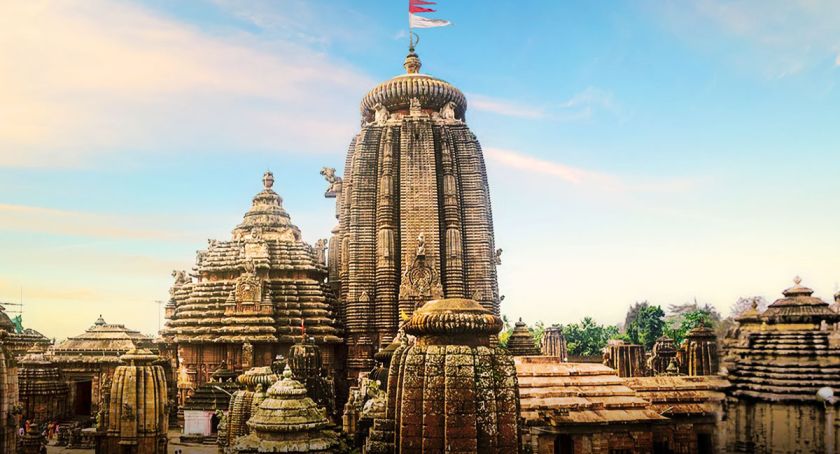The Grandeur of Lingaraja Temple
The Lingaraja Temple, an architectural wonder and a spiritual beacon, stands majestically in Bhubaneswar, Odisha. This historic temple to Lord Shiva is a major destination and a masterpiece of Kalinga architecture. With its towering structure, elaborate carvings, and rich historical significance, the temple attracts devotees and history enthusiasts. It is a religious site and a symbol of Odisha’s deep-rooted cultural heritage, drawing thousands of visitors every year who seek spiritual comfort and architectural magnificence.
The Historical Saga of Lingaraja Temple
It is thought that King Jajati Keshari of the Somavamsi dynasty constructed the Lingaraja Temple in the eleventh century. Nonetheless, historical data indicates that builders built the temple in stages, with some parts possibly dating to the sixth century. Many believe that the lingam within the sanctum represents the union of Shaivism and Vaishnavism by enshrining Lord Shiva and Lord Vishnu in the form of Harihara. This makes the temple extremely significant in Hindu mythology.
According to legend, Lord Shiva lived beneath a mango tree in Ekamra Kshetra, the original name of Bhubaneswar. People believe that Lord Shiva formed the holy Bindusagar Lake next to the temple, and they claim its water has therapeutic qualities. Before praying at the shrine, devotees ceremoniously dip in the lake.
Architectural Brilliance that Captivates Every Visitor
The Lingaraja Temple, an architectural wonder spanning over 25,000 square feet, consists of four main sections:
- Vimana (Sanctum Sanctorum) – Houses the main deity, a massive Swayambhu Lingam made of granite, which is believed to be self-manifested and holds immense spiritual significance.
- Jagamohana (Assembly Hall) – Jagamohana is where worshippers gather to offer prayers and participate in religious discourses.
- Natamandira (Festival Hall) – Used for religious dances and rituals, adding to the grandeur of temple celebrations.
- Bhoga Mandapa (Offering Hall) – Where devotees make food offerings to the deity, and the priests later distribute them as prasad.
The temple’s central tower soars 180 feet and dominates the Bhubaneswar skyline. The complex carvings on the walls depict mythological tales, celestial beings, and various deities, showcasing the unparalleled craftsmanship of ancient artisans. These sculptures narrate stories from Hindu epics like the Ramayana and Mahabharata, bringing history and mythology to life for visitors.
Sanctity and Rituals
It follows strict rituals and customs. Dedicated devotees perform daily prayers, abhishekas (ritualistic bathing of the deity), and special ceremonies during auspicious occasions. The temple’s priests adhere to age-old traditions, ensuring the shrine’s sanctity.
One of the most unique aspects of Lingaraja Temple is its worship of Lord Shiva as Harihara. This dual representation is rare in Hindu temples and highlights the temple’s profound spiritual and philosophical foundations. The temple’s interior is devoted to the heavenly energy created by the incense and rhythmic chants.
Festivals and Celebrations that Bring the Temple to Life
The temple comes alive during significant festivals, attracting thousands of devotees. Some of the key celebrations include:
- Maha Shivaratri – Maha Shivaratri is the most significant festival at Lingaraja Temple. Fasting, night-long vigils, and grand processions mark it. Devotees offer special prayers to Lord Shiva, seeking his blessings for prosperity and well-being.
- Chandan Yatra – During Chandan Yatra, devotees ritually bathe the deity and organize grand processions around the temple premises.
- Rath Yatra – During Rath Yatra, devotees take the deity on a grand procession through the streets of Bhubaneswar in a ceremonial chariot festival.
- Kartik Purnima – A special occasion when devotees gather large numbers to perform prayers and rituals.
Visitors can witness Odisha’s rich culture and ancient customs through these festivities.
The Unmatched Spiritual Experience at Lingaraja Temple
Visiting Lingaraja Temple is not just about witnessing architectural grandeur but also about experiencing deep spiritual tranquility. The sight of devotees lost in prayer, the scent of incense, and the rhythmic chanting combine to create a magical atmosphere that uplifts the spirit. Whether you are a pilgrim or a traveler, the temple offers an enriching experience that will stay with you forever.
Many visitors describe their time at Lingaraja Temple as transformative, feeling a deep sense of peace and connection with the divine. The temple’s spiritual energy is said to be powerful, making it a revered place for meditation and introspection.
Important Guidelines for Devotees and Tourists
To maintain the sacredness of the temple, visitors must follow specific guidelines:
- Entry Restrictions: Non-Hindus are not allowed inside but can view the temple from a designated platform outside.
- Photography: Photography is not permitted on the temple’s premises to preserve purity.
- Dress Code: Modest attire is required, with traditional clothing preferred to respect religious traditions.
A Divine Experience Awaits
Lingaraja Temple is a beacon of faith, history, and architectural brilliance. Anyone looking for spiritual enlightenment and cultural immersion should visit this place. Whether you visit for religious reasons or to marvel at the ancient artistry, the experience at Lingaraja Temple is genuinely unforgettable.
Arrange your trip and welcome the celestial aura emanating from this revered shrine in Bhubaneswar’s center. The temple’s rich history, stunning architecture, and profound spiritual atmosphere make it a jewel of India’s cultural heritage, leaving every visitor with awe and reverence.


